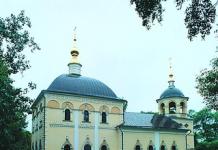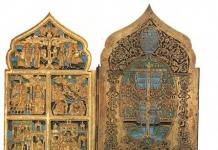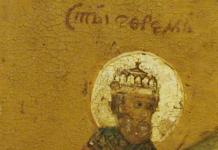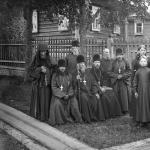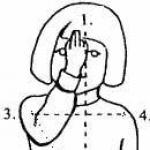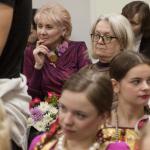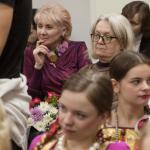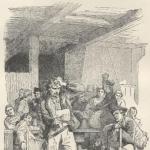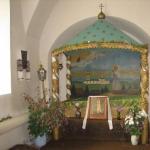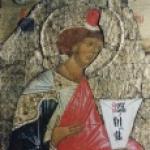It is sometimes difficult for a person with little church knowledge or little knowledge of the history of Orthodoxy to distinguish it from the New Believer (Nikonian). Sometimes a passer-by accidentally enters a church and tries to perform prayer and ritual actions “in the new style” (for example, he rushes to kiss all the icons), but it turns out that this church is an Old Believer church and similar customs exist here are not approved. An uncomfortable, embarrassing situation may arise. Of course, you can ask the gatekeeper or candle maker about the ownership of the temple, however, in addition to this, you need to know some of the signs that distinguish an Old Believer temple.
External architecture of the Old Believer temple. Bezpopovsky churches
External architecture Old Believer Church in the overwhelming majority of cases it does not differ in any way from the architecture of New Believer, Uniate and other churches. This could be a building built in the Novgorod or New Russian styles using elements of classicism, or maybe even a small house or even an impromptu temple in a wooden trailer.
 The exceptions are Old Believers priestless churches. Some of them (mainly in the Baltic states, Belarus and Ukraine) do not have an altar apse, since there is no altar itself.
The exceptions are Old Believers priestless churches. Some of them (mainly in the Baltic states, Belarus and Ukraine) do not have an altar apse, since there is no altar itself.
The eastern part of such Old Believer churches does not have an altar ledge and ends with an ordinary wall. However, this is not always visible. Whether there is an altar or not - you can definitely tell only once you are inside the temple. In Russia and some other places, Bezpopovites continue to build churches with apses, maintaining the tradition of antiquity.
As for the internal appearance, in non-priest churches, without exception, there is no altar. The iconostasis covers the wall, but not the altar; the altar is placed on the solea. In some non-priest churches, a large altar cross is installed in the center of the solea, opposite the royal doors.
The doors to the altar have a decorative function and do not open. However, in most non-priest churches there are no royal or deacon doors at all. There are several non-priest churches, the buildings of which were built in ancient times; such altars are present, but are used as additional premises: baptisms, small prayer houses, storage rooms for icons and books.
Eight-pointed cross
All Old Believer churches have eight-pointed crosses without all kinds of decorations. If there is a cross of some other shape on the temple, incl. and with the “crescent”, “anchor”, then this temple not Old Believer. And the point here is not that the Old Believers do not recognize four-pointed or other forms of crosses, but that due to the persecution of the eight-pointed cross, it was he who received a preferential position in the Old Believers.
 |  |
Inside the Old Believer Church. Candles and chandeliers
Once inside the Old Believer church, you need to look around. In Old Believer churches, practically no electric light is used during services (with the exception of the choir). Lamps in candlesticks and chandeliers burn using natural vegetable oil.
Candles for use in Old Believer churches are made from pure wax of a natural color. The use of colored candles - red, white, green, etc. - is not allowed.
Inside the Old Believer Church. Icons
An important feature of an Old Believer church is its special icons: copper-cast or handwritten, written in the so-called. "canonical style".

If the temple contains icons of famous New Believer saints - Tsar Nicholas II, Matrona, Seraphim of Sarov, then the temple is definitely not Old Believer. If there are no such icons, then you should take a closer look at the headdresses of the saints and saints depicted on the icons. If they are crowned with black or white hoods in the shape of “buckets”, then this temple is clearly not an Old Believer one. Such hoods came into fashion after the reforms of Patriarch Nikon; in the ancient Russian church, monks and saints wore completely different headdresses.
Inside the Old Believer Church. Helpers
In Old Believer churches you can also find hand tools- special mats for prostrations. Handicrafts, as a rule, are folded into neat piles on the benches of an Old Believer church.

Contrary to popular belief, supposedly in Old Believer churches there are never chairs or seats (like Catholics or Uniates), in fact, such seats are available in many (but not all) Old Believer non-priest churches in the Baltic countries.

Unison singing and clothing of believers
If a divine service takes place in a church, then an Old Believer church can be easily distinguished by its characteristic unison singing of singers. Chords, triads and generally any harmonic modes are prohibited at Old Believer Divine services. Also, certain information about the identity of the temple can be given by the clothes of believers, which are distinguished by their severity.
The cross - a symbol of the atoning sacrifice of Christ - not only marks our belonging to Christianity, but through it the saving Grace of God is sent down to us. Therefore, it is the most important element of faith. Whether it is an Old Believer cross or one of those accepted in the official church, they are equally blessed. Their difference is purely external, and is due only to the established tradition. Let's try to figure out what it is expressed in.
The departure of the Old Believers from the official church
In the middle of the 17th century, the Russian Orthodox Church experienced a severe shock caused by the reform carried out by its primate, Patriarch Nikon. Despite the fact that the reform affected only the external ritual side of worship, without touching the main thing - religious dogma, it led to a schism, the consequences of which have not been smoothed out to this day.
It is known that, having entered into irreconcilable contradictions with the official church and separated from it, the Old Believers did not remain a single movement for long. The disagreements that arose between its religious leaders caused it to soon split into dozens of groups called “talks” and “concords.” Each of them was characterized by its own Old Believer cross.
Features of Old Believer crosses
How does the Old Believer cross differ from the usual one, the one accepted by the majority of believers? It should be noted here that the concept itself is very conditional, and we can only talk about certain of its external features accepted in the religious tradition. The Old Believer cross, the photo of which is presented at the beginning of the article, is the most common.

This is an eight-pointed cross inside a four-pointed one. This form was widespread in the Russian Orthodox Church in the middle of the 17th century at the time of the schism and was in full accordance with canonical requirements. It was her that the schismatics considered most consistent with the concepts of ancient piety.
Eight-pointed cross
The eight-pointed shape of the cross itself cannot be considered an exclusive property of the Old Believers. Similar crosses are common, for example, in the Russian and Serbian Orthodox Churches. The presence in them, in addition to the main horizontal crossbar, of two more is explained as follows. The top one - a small crossbar - should depict a tablet nailed to the top of the cross on which the Savior was crucified. On it, according to the Gospel, there was an abbreviation of the inscription: “Jesus of Nazareth, King of the Jews.”
The lower, inclined crossbar, depicting the footrest of the crucified Christ, is often given a very specific meaning. According to established tradition, it is considered to be a kind of “standard of righteousness” that weighs human sins. Its tilt, in which the right side is raised up and points towards the repentant thief, symbolizes the forgiveness of sins and the acquisition of the Kingdom of God. The left one, lowered down, indicates the depths of hell, prepared for the unrepentant thief who blasphemed the Lord.

Pre-reform crosses
The part of believers that broke away from the official church did not invent anything new in religious symbolism. The schismatics only preserved those elements of it that existed before the reform, while refusing any innovations. For example, a cross. Whether it is Old Believer or not, it is, first of all, a symbol that has existed since the beginning of Christianity, and the external changes that it has undergone over the centuries have not changed its essence.
The most ancient crosses are characterized by the absence of an image of the figure of the Savior. For their creators, only the form itself, which carried the symbol of Christianity, was important. This is easy to notice in the crosses of the Old Believers. For example, the Old Believer pectoral cross is often performed in precisely this ancient tradition. However, this does not distinguish it from ordinary crosses, which also often have a strict, laconic appearance.
Copper cast crosses
More significant are the differences between Old Believer copper-cast crosses belonging to different religious denominations.

The main distinguishing feature of them is the pommel - the upper part of the cross. In some cases, it depicts the Holy Spirit in the form of a dove, and in others, a miraculous image of the Savior or the God of Hosts. These are not just different artistic solutions, these are their fundamental canonical principles. Looking at such a cross, a specialist can easily determine whether it belongs to one or another group of Old Believers.
So, for example, the Old Believer cross of the Pomeranian Concord or the Fedoseevsky type, which is close to them, never bears the image of the Holy Spirit, but it can always be recognized by the image of the Savior Not Made by Hands, placed at the top. If such differences can still be attributed to an established tradition, then there are agreements and purely fundamental, canonical disagreements in the design of crosses.

Pilate's inscription
Often the reason for disputes is the text of the inscription on the upper, small crossbar. It is known from the Gospel that the inscription on the tablet attached to the cross of the Savior was made by Pontius Pilate, by whose order Christ was crucified. In this regard, the Old Believers have a question: is it worthy for the Orthodox Old Believer cross to bear an inscription written by one who is forever cursed by the church? Its most ardent opponents have always been the above-mentioned Pomeranians and Fedoseevites.
It is curious that disputes over the “Pilate inscription” (as the Old Believers call it) began in the first years of the schism. One of the prominent ideologists of the Old Believers, Archdeacon of the Solovetsky Monastery Ignatius, is known for having compiled several very voluminous treatises condemning this title, and even submitted a petition about this to the sovereign Alexei Mikhailovich himself. In his writings, he argued that such an inscription was inadmissible and urgently demanded that it be replaced with the abbreviation of the inscription “Jesus Christ King of Glory.” It would seem like a minor change, but there was a whole ideology behind it.

The cross is a common symbol for all Christians
Nowadays, when the official church has recognized the legitimacy and equality of the Old Believer Church, in Orthodox churches you can often see the same crosses that previously existed only in schismatic monasteries. This is not surprising, since we have one faith, the Lord is one, and asking the question of how the Old Believer cross differs from the Orthodox cross seems incorrect. They are essentially united and worthy of universal worship, since, despite minor external differences, they have common historical roots and equal grace-filled power.
The Old Believer cross, the difference from the usual one, as we found out, is purely external and insignificant, is rarely an expensive piece of jewelry. Most often, he is characterized by a certain asceticism. Even the Old Believer golden cross is not common. Most of them are made from copper or silver. And the reason for this is not at all in economy - among the Old Believers there were many wealthy merchants and industrialists - but rather in the priority of internal content over external form.

Community of religious aspirations
The Old Believer cross on the grave is also rarely distinguished by any pretentiousness. It is usually eight-pointed, with a gable roof installed on top. No frills. In the tradition of the Old Believers, greater importance is attached not to the appearance of the graves, but to the care for the repose of the souls of the deceased. This is fully consistent with what the official church teaches us. We all equally pray to God for our relatives, loved ones and simply brothers in faith who have completed their earthly journey.
Long gone are the times of persecution of those who, due to their religious views or due to prevailing circumstances, found themselves in the ranks of a movement that escaped the control of the supreme church administration, but nevertheless remained in the bosom of Christ’s Church. Having officially recognized the Old Believers, the Russian Orthodox Church is constantly looking for ways to become even closer to our brothers in Christ. And therefore, the Old Believer cross or the icon, painted according to the canons established in the old faith, became fully objects of our religious veneration and worship.
The Old Believers' cross is one of the symbols of faith, which is used for worship, baptism and other religious procedures. The eight-pointed cross is different from the usual Orthodox one. The modern church does not use the eight-pointed cross after Nikon’s reform, but the Old Believers or schismatics, as they were called in the old days, continue to use just such a cross, not paying attention to the reforms carried out.
History of persecution
It all started quite a long time ago; it is noteworthy that the schism of the church caused the death of a large number of people who supported the old faith. But, despite this, the Old Believers were able to survive executions, public reprisals and catastrophically high taxes. Old Believers still exist; there are about two million of them in Russia alone.
Old Believer's vest
In 1650–1660, the church split into two camps. The reason for it was the reform. Some took ignorance for granted, others began to believe that the reform was trying to impose on them a foreign faith that had nothing to do with Orthodoxy.
The church reform of Nikon and Tsar Alexei Mikhailovich, in fact, divided people and became the cause of serious disagreements. As a result, the disputes turned into active actions, which led to mass repressions against those people who did not support the innovations.
Nikon's reforms began in 1653, and the reaction to the metropolitan's activities was not long in coming. In 1656, a significant event took place at the Local Council of the Russian Orthodox Church: everyone who was baptized with two fingers was declared heretics. The cross was replaced, and books, scrolls and other symbols were to be destroyed. All those who continue to make the sign of the cross with two fingers and practice the old faith will be excommunicated and anathematized.
Not everyone agreed with this decision; the disagreements that arose led to the fact that faith was under threat. The country could plunge into a religious war. The situation was aggravated by the actions of the clergy, who independently escalated the situation. Wanting to subjugate the Old Believers to their will, they adopted a document called “12 Articles.”
Mass executions and reprisals against Old Believers began after the Pomeranian Gathering; Queen Sophia failed to influence the situation. However, the country was in a precarious position, and religious executions and forgeries only worsened the situation. The “12 Articles” did not resolve the situation; after their release, a series of forgeries appeared, lies and unrest led to the execution of thousands of innocent citizens, and priests also suffered.
Despite the fact that books, scrolls and the Old Believers themselves were subjected to persecution and public executions, they managed to survive the Time of Troubles. The situation was resolved with the coming to power of Peter the Great. The emperor was relatively loyal to the Old Believers. He allowed them to exist and abolished the 12 Articles. But this existence was semi-legal.
In law:
- Marriages of Old Believers were considered illegal.
- Old Believers were prohibited from holding high positions.
- Baptism was considered illegal.
- Children born in marriage with Old Believers were considered illegitimate.
In addition, all those who deviated from religion had to pay double tax. If a person evaded paying the tax, he could be executed, tortured, or sent to hard labor.

Old Believer eight-pointed cross
Despite the fact that the Old Believers were still subject to repression, their weakening made it possible to save the lives of many people. To maintain their usual way of life and avoid reproaches and taxes, many believers went into the forests or immigrated. This allowed them not only to continue to live normally, but also to legalize their marriages. In the territories of a large number of countries, Old Believers lived in communities, built houses and churches.
According to some information, in the 19th century, Old Believers comprised a third of the entire population of the Russian Empire.
In 1846, thanks to the efforts of Metropolitan Ambrose, it was possible to alleviate the situation in the country; the authorities made certain compromises, as a result of which unity of faith was introduced. On the territory of Austria-Hungary, the Old Believers managed to restore the diocese. But not everyone accepted the metropolitan and his decisions; some of the Old Believers began to consider him a heretic who wanted to influence them and destroy their religion.
In 1883, it was possible to achieve some relief in relation to the Old Believers; they were allowed to hold public positions. Later, in 1905, a decree was issued that partially lifted the restrictions on citizens who were baptized with two fingers and using an eight-pointed cross.
The USSR authorities treated representatives of this religious trend relatively favorably. Despite the fact that the Bolsheviks did not accept faith and God, they had no special complaints against the Old Believers. While clergy throughout the country feared for their lives, churches were destroyed and looted, icons were burned and sold, the Old Believers lived relatively calmly.
During the Second World War, some Old Believers, no matter what, rushed to defend their homeland from enemies, while others preferred to hide in the forests.
When hard labor, high taxes and executions were a thing of the past, many Old Believers decided to return to Russia. Today there are several large settlements that are located on the territory of our country, in which people live on farms, engage in farming, harvesting, go to church and still cross themselves with two fingers.
Symbolism and features
The eight-pointed cross is considered one of the symbols of the Old Believers; the four-pointed and six-pointed symbols of faith are considered inferior. According to legend, it was this kind of cross that Queen Helen discovered on Mount Golgotha.
So, what does this symbol indicate:
- contains, in addition to the large crossbar, two more;
- the upper crossbar symbolizes the tablet on the cross with the name of Christ on which he was crucified;
- the bottom bar is for Jesus' feet;
- on the top crossbar there is the inscription “Jesus of Nazareth, King of the Jews.”
With the lower crossbar, which is intended for the legs, everything is more difficult. According to legend, if the left edge of the lower crossbar is raised, then this indicates that the sinner has repented, and his sins and righteous deeds when placed on the scales allowed him to be sent to heaven. If the edge of the crossbar looks down, it means that the sinner during the crucifixion did not repent of his sins, did not ask for forgiveness from God, and thereby aggravated his sins and went to hell.
Such crosses with three crossbars are used only by Old Believers; in the modern Orthodox Church they use a four-pointed cross during liturgies and services. It doesn't have a footrest or sign.
According to legend, when Jesus was crucified on the cross, one of the criminals began to mock him. He said, “If you are God, then set us free.” And the other criminal said: “He is innocent and convicted by mistake, but we are the real criminals.” The criminal who told the truth was sent to heaven. This is evidenced by the lower support under the feet, the edge of which has risen.
Beginning in 1577, the eight-pointed cross was placed on the coat of arms of the Russian state; the situation changed in 1625 even before Nikon’s reforms: it was decided to replace the cross with the third crown.
You can also find images that were used during the war: the banners depicted an eight-pointed cross in red, green or blue. But such banners also date back to the 1630s; after the reform, banners with similar crosses were no longer used.
There is another type of religious symbol - this is the cross of Golgotha, a monastic symbol. It is an eight-pointed cross placed on a symbolic image of Mount Golgotha, which most often looks like several steps. That is, the cross is placed on the steps, on one side there is a spear, on the other there is a cane with a sponge.
The symbol contains the following inscriptions:
- Above the middle crossbar ІС ХС - the name of Jesus Christ.
- Below it is the Greek inscription Nike - Winner.
- SNЪ BZHIY - the inscription on or near the tablet (can be replaced by the abbreviation ІНЦІ - Jesus of Nazareth, King of the Jews).
- The inscription above the sign: TsRЪ SLVY - King of Glory.
- There are also two letters K and T, which stand for a cane and a spear with a sponge.
In the 16th century, a tradition appeared in Rus', which consisted in placing additional letters near the image of Golgotha.
M L R B - the place of execution was crucified; G G - Mount Golgotha; G A - head of Adam. It was also customary to depict bones and a skull under the steps. In Rus', these images have changed a little.
Currently, the cross from Mount Golgotha is not widespread, and it is quite difficult to come across it.
You can see eight-pointed crosses not only at liturgy and services, but also in Old Believers’ cemeteries.
The Old Believers have several more features that are worth mentioning, in addition to the cross: believers bow to the ground, like Muslims, into the ground. When bowing, the believer must touch the ground with his knees and forehead. Only Old Believers prefer such bows. When believers pray, they touch their knees and foreheads not to the ground, of course, but to the prayer rug.
Another feature of the Old Believers' worship service is singing. Before Nikon's reform, all churches sang with one voice during services. The singing remains monotonous and melodic. Regardless of how many people are involved in singing, the voices must merge into one voice, one melody.
But due to the large number of vowels, it can be difficult to understand what they are singing about during worship.
There are several other features that distinguish the faith of the Old Believers from the modern Orthodox faith:
- writing the name Jesus without the additional letter “I” (that is, the name is written with one letter “I”, and not in the Greek manner with two letters);
- believers use ancient terms and adhere to the ancient spelling of words;
- baptism of children takes place with complete three-time immersion in water;
- services are held according to the Jerusalem Rule;
- the safety of the actions performed during the ritual is noted.
Undoubtedly, the eight-pointed cross can be considered a bright religious symbol of the Old Believers. It is placed on the domes of churches, worn on the body and placed as a monument on the grave of the deceased. But the traditions of the Old Believers, their way of life and behavior have undergone certain changes over time. Despite all the events, people managed to survive difficult times and maintain their faith.
Religious reading: Old Believer cross prayer to help our readers.
providenie.narod.ru
Preface
Whether it is an Old Believer cross or one of those accepted in the official church, they are equally blessed. Their difference is purely external, and is due only to the established tradition. Let's try to figure out what it is expressed in.
The departure of the Old Believers from the official church
It is known that, having entered into irreconcilable contradictions with the official church and separated from it, the Old Believers did not remain a single movement for long. The disagreements that arose between its religious leaders caused it to soon split into dozens of groups called “talks” and “concords.” Each of them was characterized by its own Old Believer cross.
Features of Old Believer crosses
This is an eight-pointed cross inside a four-pointed one. This form was widespread in the Russian Orthodox Church in the middle of the 17th century at the time of the schism and was in full accordance with canonical requirements. It was her that the schismatics considered most consistent with the concepts of ancient piety.
Eight-pointed cross
The presence in them, in addition to the main horizontal crossbar, of two more is explained as follows. The top one - a small crossbar - should depict a tablet nailed to the top of the cross on which the Savior was crucified.
On it, according to the Gospel, there was an abbreviation of the inscription: “Jesus of Nazareth, King of the Jews.” The lower, inclined crossbar, depicting the footrest of the crucified Christ, is often given a very specific meaning.
According to established tradition, it is considered to be a kind of “standard of righteousness” that weighs human sins. Its tilt, in which the right side is raised up and points towards the repentant thief, symbolizes the forgiveness of sins and the acquisition of the Kingdom of God.
The left one, lowered down, indicates the depths of hell, prepared for the unrepentant thief who blasphemed the Lord.
Pre-reform crosses
For example, a cross. Whether it is Old Believer or not, it is, first of all, a symbol that has existed since the beginning of Christianity, and the external changes that it has undergone over the centuries have not changed its essence.
The most ancient crosses are characterized by the absence of an image of the figure of the Savior. For their creators, only the form itself, which carried the symbol of Christianity, was important.
This is easy to notice in the crosses of the Old Believers. For example, the Old Believer pectoral cross is often performed in precisely this ancient tradition.
However, this does not distinguish it from ordinary crosses, which also often have a strict, laconic appearance.
Copper cast crosses
The main distinguishing feature of them is the pommel - the upper part of the cross. In some cases, it depicts the Holy Spirit in the form of a dove, and in others, a miraculous image of the Savior or the God of Hosts.
These are not just different artistic solutions, these are their fundamental canonical principles. Looking at such a cross, a specialist can easily determine whether it belongs to one or another group of Old Believers.
So, for example, the Old Believer cross of the Pomeranian Concord or the Fedoseevsky type, which is close to them, never bears the image of the Holy Spirit, but it can always be recognized by the image of the Savior Not Made by Hands, placed at the top.
If such differences can still be attributed to an established tradition, then there are agreements and purely fundamental, canonical disagreements in the design of crosses.
Pilate's inscription
In this regard, the Old Believers have a question: is it worthy for the Orthodox Old Believer cross to bear an inscription written by one who is forever cursed by the church? Its most ardent opponents have always been the above-mentioned Pomeranians and Fedoseevites.
It is curious that disputes over the “Pilate inscription” (as the Old Believers call it) began in the first years of the schism. One of the prominent ideologists of the Old Believers, Archdeacon of the Solovetsky Monastery Ignatius, is known for having compiled several very voluminous treatises condemning this title, and even submitted a petition about this to the sovereign Alexei Mikhailovich himself.
In his writings, he proved the inadmissibility of such an inscription and urgently demanded that it be replaced with the abbreviation of the inscription “Jesus Christ King of Glory.” It would seem like a minor change, but there was a whole ideology behind it.
The cross is a common symbol for all Christians
This is not surprising, since we have one faith, the Lord is one, and asking the question of how the Old Believer cross differs from the Orthodox cross seems incorrect. They are essentially united and worthy of universal worship, since, despite minor external differences, they have common historical roots and equal grace-filled power.
The Old Believer cross, the difference from the usual one, as we found out, is purely external and insignificant, is rarely an expensive piece of jewelry. Most often, he is characterized by a certain asceticism. Even the Old Believer golden cross is not common. Most of them are made from copper or silver.
And the reason for this is not at all a matter of economy - there were many wealthy merchants and industrialists among the Old Believers - but rather the priority of internal content over external form.
Community of religious aspirations
In the tradition of the Old Believers, greater importance is attached not to the appearance of the graves, but to the care for the repose of the souls of the deceased. This is fully consistent with what the official church teaches us. We all equally pray to God for our relatives, loved ones and simply brothers in faith who have completed their earthly journey.
Long gone are the times of persecution of those who, due to their religious views or due to prevailing circumstances, found themselves in the ranks of a movement that escaped the control of the supreme church administration, but nevertheless remained in the bosom of Christ’s Church.
Having officially recognized the Old Believers, the Russian Orthodox Church is constantly looking for ways to become even closer to our brothers in Christ. And therefore, the Old Believer cross or the icon, painted according to the canons established in the old faith, became fully objects of our religious veneration and worship.
Prayer to the Life-Giving Cross - examples of prayer texts to the Cross of Christ
Veneration of the Cross in Orthodoxy
At the same time, timid attempts to reduce the whole problem to the level of allegory and theological metaphor are not convincing due to the immutable patristic rule: the law of prayer is the law of faith. That is, the prayer to the Life-Giving Cross, practiced in Orthodoxy, implies faith in the personified existence of a certain cross endowed with consciousness.
However, the purpose of this article is not to delve into the theological issues of crucifixion, but to illustrate this practice using the example of several of the most popular prayers.
Basic prayer to the honorable Life-Giving Cross
“Let God rise again and let his enemies be scattered! And let those who hate him flee from his face! Just as smoke disappears, so they will disappear, just as wax melts in the face of flame, so will the demons perish in the face of those who love God, making the sign of the cross and exclaiming in joy: “Rejoice, revered by all the Life-giving Cross of the Lord! Drive out the demons by the power of our Lord Jesus Christ crucified on you, who descended into hell and trampled upon the power of the devil and gave us you - your revered Cross, in order to drive out every enemy. Oh, most venerable and life-giving Cross of the Lord! Help me together with the holy Lady Virgin Mary and together with all the saints forever. Amen".
This prayer to the Life-Giving Cross is part of the so-called evening prayer rule and is read every evening by all believers. Its first verses are taken from Psalm 67, interpreted in the light of the dogma of the resurrection of Jesus Christ from the dead. There is another commonly used prayer to the Life-giving Cross of the Lord, which, however, is not so well known and, moreover, more extensive. You can find it below.
Alternative prayer to the Cross
This prayer to the Life-Giving Cross is not used in worship, but is distributed in prayer books and other collections of prayer texts intended for home use.
Brief appeals
“Protect me, Lord, by the power of your venerable Life-giving Cross and save me from all evil.”
There are other prayers to the Cross, sometimes very long - canons, akathists, which can be easily found in church shops.
How do Orthodox Christians get baptized and why is it necessary?
Types of the sign of the cross
Three fingers are a symbol of the Holy Trinity. Double-fingering is considered more ancient and dates back to the times of the Old Believers. In the double-fingered sign of the cross, the index and middle fingers are folded as a sign of the unity of the divine and human nature of Christ.
Only priests use the sign of the cross. It is called that because it symbolizes the name of Christ. So, how do Orthodox Christians get baptized? Parishioners use three fingers. The double-fingered and nominative finger formation is used by clergy and is also depicted on icons. The latter is also used by priests when consecrating objects.
How Orthodox Christians are baptized: features
In Catholicism, more attention is paid to worldly life, and many Orthodox traditions, although they exist, have either been abolished or are carried out by parishioners on the principle of “whoever knows how.” So, how do Orthodox Christians get baptized?
The fingers should be folded into three fingers, after which the hand is brought first to the forehead, then to the navel, and then from the right shoulder to the left. But why do Orthodox Christians get baptized in this way? This has a special meaning. The right side in Christianity has always been considered the side of salvation, and the left is the place of perishing.
That is, in this way an Orthodox Christian asks to be counted among the saved. Catholics do the opposite: from left to right. For them, such a gesture means that they are opening their hearts to God. Some Orthodox Christians interpret their sign of the cross as follows: they close their hearts from Satan.
So: why do Orthodox Christians cross themselves from right to left, and Catholics from left to right?
So, until 1570, Catholics were allowed to be baptized both from right to left and from left to right. But then Pope Pius V insisted on doing it from left to right and nothing else. “Blessing himself. makes a cross from the forehead to the chest and from the left shoulder to the right,” said the great messenger of God.
The fact is that when you move your hands in this way, the sign of the cross, according to Christian symbolism, comes from a person who is turning to God. And when you move your hand from right to left, it comes from God, who blesses a person.
Note: it is not for nothing that both Orthodox and Catholic priests cross those around them from left to right (looking from themselves). This is a kind of blessing gesture.
In addition, what is interesting is that the movement of the hand from left to right signifies the transition from sin to salvation, since the left side in Christianity is associated with the devilish force, and the right side with the divine.
And with the sign of the cross from right to left, moving the hand is interpreted as a victory of the divine over the devil. Just like that! If this fact was interesting to you, then share the article with your friends.
Conscientious Accuracy
Any way of making the sign of the cross over yourself or other people must carry a semantic load, and here you must choose for yourself what is more important for you: open your heart to the Lord or close it from Satan. Therefore, you need to be interested not only in how Orthodox Christians are baptized, but also in why they do it.
Remember that putting a symbolic Orthodox cross on yourself means bearing a great responsibility.
Church schism: struggle for piety or power
Interpretation of church schism
Soviet scientists began to adhere to the same point of view. In Russia, especially in Tsarist Russia, the church has always been assigned the role of spiritual guardian and ruler of souls. Which, in fact, is quite understandable - then religion in the state was part of politics.
In Soviet times, it was generally accepted to interpret any events as a struggle of the oppressed masses.
Historical facts
Amendments were made to the service of the liturgy and to the Psalter. This is considered the main reason for the disagreement. But the church schism occurred later, when Patriarch Nikon received greater preferences from Tsar Alexei Mikhailovich, father of Peter the Great.
He could make decisions regarding church life himself. Many modern historians are confident that this is the real reason for the disagreement.
The attitude of the masses to the split
Studying the documents, scientists came to the conclusion that passions were in full swing among the clergy, who initially looked for supporters among representatives of the nobility, and only then slaves were used.
These were already attempts to organize acts of disobedience. The bulk of the people remained indifferent to this process. Most likely, because I didn’t even understand what all the fuss was about.
The archpriests who were part of the community of zealots of antiquity were arrested and exiled. A small part of the people who remained faithful to the previous canons were outlawed. Many of them fled and founded Old Believers settlements in Siberia.
They remained there until the revolution and many left the country during the civil war. A considerable part of them settled in South America.
Nikon's fate
This was not enough for him; he declared church power higher than royal power, which led to a conflict with the ruler and the loss of the highest favor.
Nikon had to leave the patriarchal throne; by the council of 1666-1667 he was deprived of his dignity and exiled to the Ferapontov Monastery.
But the changes he introduced in the conduct of religious services have remained in place to this day.
Related links
Did you read the article to the end? Please take part in the discussion, express your point of view, or simply rate the article.
Cross “CALVAYA CROSS. PRAYER TO THE CROSS" (Old Believer)
Availability: In stock
Manufacturer: Yuri Fedorov Workshops
Free shipping
The product is consecrated
Our cross reproduces the type of pectoral cross widely used in the Old Believer Church, which arose in Rus' in the 17th century.
Its characteristic features are a simple four-pointed shape with straight beams, where the vertical beam is longer than the horizontal one, and a fixed round top with a two-tier pyramid.
The central and main element of the composition of the front side is the eight-pointed cross - the image of the Honest and Life-Giving Cross of the Lord, installed on Mount Golgotha. Inside the mountain there is a skull depicting the head of Adam, because According to legend, Adam's remains were buried in this place. In addition, the connection between Christ and Adam is thus noted. The Fathers of the Church call Christ the New Adam, who atoned for original sin and opened the path to eternal life for man. On the sides of the Calvary Cross are depicted the instruments of the passions - a spear and a cane with a sponge. Along with the Cross, they are worshiped, therefore the spear and the cane are invariably present on all Old Believer crosses, forming a single composition with the eight-pointed cross and Golgotha. According to the opinion prevailing among the Old Believers, the image of the Savior cannot be depicted on body crosses, because the cross is never allowed to be removed, and at the same time a person has to go to places where it is indecent to bring the image of the Savior.
On the free field of the cross there are traditional inscriptions of a doctrinal and glorifying nature. At the top of the cross is Tsr slavy (Tsar Glory), an inscription that appeared on Byzantine crosses no later than the 12th century. (ΒΑΣΙΛΥΣ ΤΗΕ ΔΟΞΗΣ), the antonym of the ironic Pilate inscription, speaking of the Ascension of the Lord in Glory. At the edges of the horizontal beam is I&C X&C (Jesus* Christ), confirming the Messiahship of the Savior promised by the Old Testament. Along the horizontal beam is NIKA (Winner), reminiscent of Christ’s victory over hell and death.
The inscription I&С Х&С NIKA was first written on crosses made by order of Emperor Constantine immediately after the acquisition of the Honest and Life-Giving Cross of the Lord by Queen Helena.
It is worth dwelling separately on the meaning of the eight-pointed cross, about which there was so much controversy in the history of the post-reform Church, and which today is not only especially revered by the Old Believers, but is also a symbol of the entire Russian Orthodox Church.
The eight-pointed cross as an image of the instrument of execution of the Savior has been found in church art since the 9th century. And by the 16th century. in Rus', the image of the Calvary Cross became predominantly eight-pointed. This graphic form, which has developed over the centuries, is the best spiritual image of the true cross of the Lord - a symbol of the Sacrifice and Victory of the Savior. The eight-pointed form, in turn, consists of three parts - the four-pointed cross itself and two additional horizontal crossbars at the top and bottom.
The four-pointed cross graphically repeats the figure of the crucified Savior, “Who created and contains everything above and below, who united the above with the earthly, descended from above to earth, and then ascended from earth to heaven; He united everything in Himself and called all the ends of the earth to Himself.”
The top bar represents Pilate's title, mentioned in all four Gospels. But Pilate’s inscription of the Savior’s imaginary guilt “Jesus of Nazareth – King of the Jews” until the 16th century. was not used on crosses, because its false content and mocking character were incompatible with the worship of the Cross. Instead, the true title of the Savior “Jesus Christ the King of Glory” was written, or more often just the abbreviated name of the Lord I&C X&C. After all, titles (titulus - lat.) in the Roman tradition were called “plates that signified royal power with the image of emperors or the writing of their name.”
On Russian crosses of Pilate, the inscription on the title is in the form of the Slavic abbreviation I.N.Ts.I. appears since the 17th century. and is usually present only in conjunction with the figure of the crucified Christ. However, on the eight-pointed crosses themselves without the Crucifixion, the inscriptions are not depicted, but are written next to them.
Thus, the upper crossbar, crowning the cross, denotes the true dignity of the Savior in accordance with the nearby inscriptions.
The bottom crossbar represents the foot. Despite the fact that the Gospel does not speak about the foot and there is no reliable archaeological data about its existence, it is mentioned by many Church Fathers and has been present in Byzantine and Russian images of the Crucifixion since ancient times.
Most researchers believe that the foot, according to the Byzantine ceremony, signifies the greatness of the person depicted. It shows the Cross as the throne of Christ, as a king, the King of Glory. In addition, the Cross is also perceived as an altar, the indispensable attribute of which is the foot. Thus, the footstool on the cross shows the crucified Christ not only as a sacrifice, but also as the High Priest who offers it. We find confirmation of these meanings of the footstool in many books of Holy Scripture (Is.60.13; Ps.98.5; Ps.131.7; Matt.22.44; Heb.10.12 - 13). Given such an important meaning of the foot, the Cross itself is often called the foot, and not just its separate part.
In the context of these meanings, the foot on ancient crosses had a three-dimensional cubic shape, was sometimes decorated with ornaments and was similar to the foot depicted on icons at the throne of the Almighty. Let us remember that the figure of the crucified Christ in those days also had the features of royal dignity. Over time (from the 9th century), the volumetric base in Byzantine and Russian art turned into a wide board. In Russian crosses of the 16th–17th centuries. it began to be depicted as beveled with its right end up. The foot of this form became popular and established itself in Russian icon painting and acquired a new symbolic meaning - “the righteous standard.” The beveled foot on the cross reminds us of the two thieves crucified on the sides of Christ, and represents the yoke of the scales of the Last Judgment. One end is lowered down under the weight of the sins of the unrepentant, bringing him down to hell, and the other, freed by the repentance of the prudent thief, is raised up, lifting him, according to the Savior’s promise, to paradise. This symbolically highlights the meaning of repentance as the path to salvation.
In addition, the reminder of the crucified thieves recreates the complete picture of the Crucifixion with three crosses, the important symbolic meaning of such a composition is to show the restoration of the lost paradise with two trees in the center. And then the Cross of Christ is the image of the Tree of Life, and the crosses of the thieves personify the dualism of the tree of the knowledge of good and evil. It is possible that, combining the symbolism of the trees of paradise, the eight-pointed cross with an oblique foot becomes the “Three-part Honest Tree”, sung in the canon of the Honest and Life-Giving Cross (canto 8).
On the reverse side of our cross there is the text of a prayer to the Honest and Life-Giving Cross in pre-reform writing: May God rise again, and may his enemies be scattered, and may those who hate him flee from his face: as smoke disappears, may they disappear, as wax melts from the face of fire, so yes Demons will perish on behalf of those who love God and knowledge.
*This spelling of the name of Christ was used before the church reform of 1651-1685, and is still accepted in the Old Believer Church to this day.
Our cross can be made in silver with blackening and fragmentary gilding (Art. KS109) or decorated with hot enamel of various colors (Art. KS109/1).
The Orthodox Old Believer cross has a slightly different shape from the four-pointed one that is widespread in our time. It has two crosshairs at an angle of ninety degrees, where the upper crossbar signifies the tablet attached above Christ with the inscription “Jesus of Nazarene, King of the Jews,” and the slanting lower crossbar, which symbolizes the “measure” that evaluates the good and bad deeds of all people. Its tilt to the left means that the repentant thief was the first to go to heaven.
What feature does such a cross have? The Old Believer pattern is sometimes included in a larger four-pointed cross and never has a figure of the crucified Jesus. This is interpreted to mean that this symbol should mean the Crucifixion, but not depict it. If the figure of Christ were present on the cross, then the cross would become an icon, which was intended not for wearing, but for prayer. Carrying an icon in a hidden form (Old Believers never wear it in plain sight) means for this group of believers using it for other purposes (as an amulet, which is an unacceptable action).
The Old Believer cross differs in its shape for wearing by men and women. For representatives of the stronger sex, it has clear quadrangular boundaries, while religious ladies wear this symbol, surrounded by additional space, shaped like a petal of smooth shapes. On the reverse side of the cross there is a prayer “May God rise again and his enemies be scattered...” or a troparion to the Cross.

When did this cross appear? The Old Believer version has existed in Rus' since ancient times. But during the reforms of Patriarch Nikon in the 1650s, they began to condemn him, along with other symbols of those who refused to accept church innovations. In particular, many people did not accept the three-finger instead of the two-finger, as well as the three-time proclamation of “Hallelujah” instead of the two-time one. The Old Believers believed that the threefold kathisma contradicted the will of the Mother of God.
What did the schism in Rus' lead to, one of the symbols of which was the cross? In the mid-seventeenth century, the Old Believers were forced to flee from the central regions of the country to the outskirts, where communities and sects formed. The latter had many wonderful customs. For example, the Ryabinovsky tradition worshiped only a cross made of mountain ash. All adherents of the old church traditions were united by a closed existence and exceptional strictness in observing the primordial, in their opinion, ceremonies. In a number of cases, when trying to convert a settlement to a new faith, people resorted to mass self-immolation. In some years, the number of victims reached tens of thousands.

Where can you see Old Believer crosses today? Photos of settlements where just such believers live are quite widespread. Such settlements can be found in the center of Russia and Altai. There are even excursions to get acquainted with the life and life of this cultural layer. However, when visiting the village you most likely will not see them, because... Old Believers still wear them strictly under their clothes.
